The late 1990s seemed like a revival for musical styles that had lost their prior appeal while also propelling newer genres to heights never reached. Amidst the superficial boasting, sparkling attire, and the common cliches of the late ’90s, a group emerged. Comprising strong vocalists, eloquent lyricists, masterful instrumentalists, producers, rappers, and many others, the Soulquarians came to life.
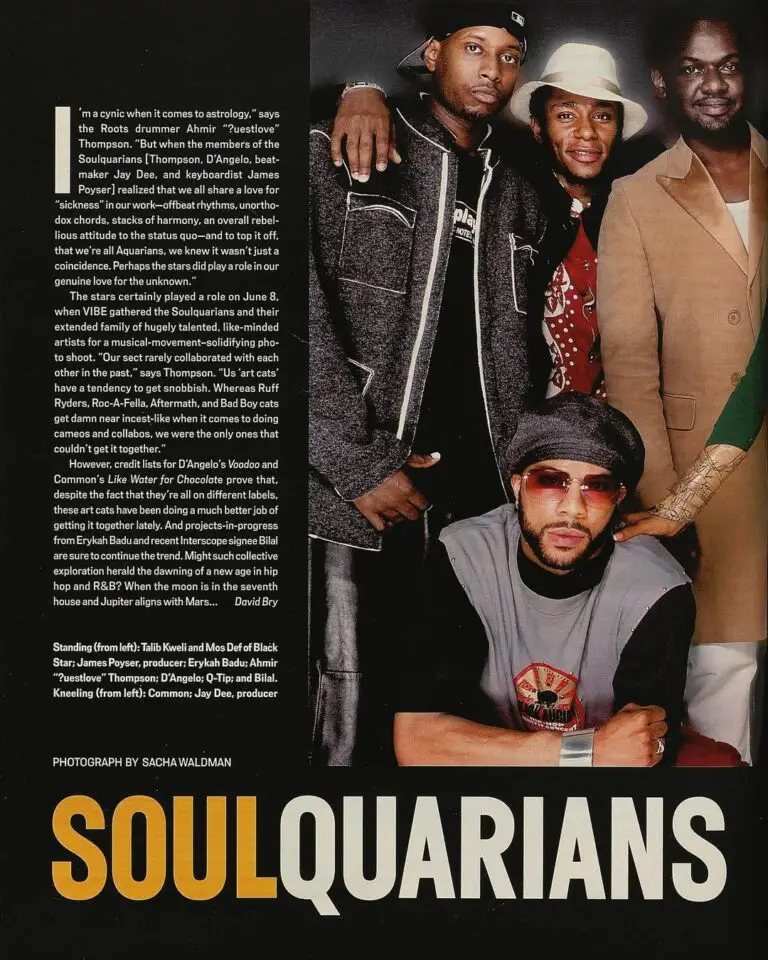
Guided by Questlove from The Roots and energized by the brilliance of D’Angelo, J. Dilla, Erykah Badu, Common, Mos Def, Q-Tip, Talib Kweli, Bilal, James Poyser, and Pino Palladino, this collective flourished through collaboration, producing albums that would eventually become enduring masterpieces. The name Soulquarians comes from the fact that the founders of this group all share the same astrological sign, as J. Dilla, D’Angelo, Questlove, and Poyser are all Aquariuses.
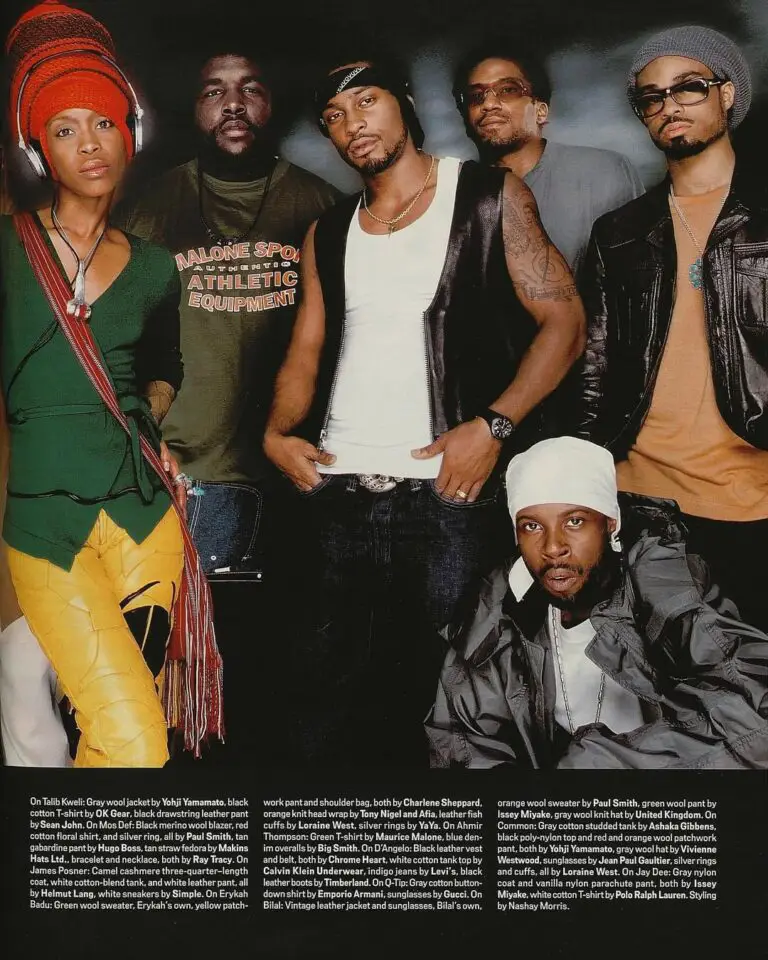
The Beginning of Soulquarians
A key moment in the origins of the Soulquarians took place at the 1995 Source Awards, an event that had polarized the hip-hop community. The ceremony occurred during a notable period of hip-hop conflicts, such as Suge Knight ridiculing Diddy, Andre 3000 proclaiming “the south’s got something to say,” and Snoop Dogg and Dr. Dre facing boos on stage. The tumultuous atmosphere of that evening led Questlove to recognize the importance of having a cohesive music scene, despite The Roots never being affiliated with other artists and not aligning with the West Coast, East Coast, or even Southern scenes that groups like OutKast and others were carving out for themselves.
Questlove had previously heard about D’Angelo and initially dismissed him as just another R&B musician, but this newfound understanding allowed him to approach the tape he received with a fresh perspective. The tape he obtained was D’Angelo’s 1995 album Brown Sugar, and after listening to it, he recognized the artist’s potential.
D’Angelo’s music showed clear inspiration from the hip-hop collective A Tribe Called Quest, which also played a role in shaping the Roots’ musical style and influenced Questlove’s stage name. This development coincided with Questlove’s understanding that he required a vibrant music scene to succeed in the industry and discover artists he was eager to collaborate with and be linked to.
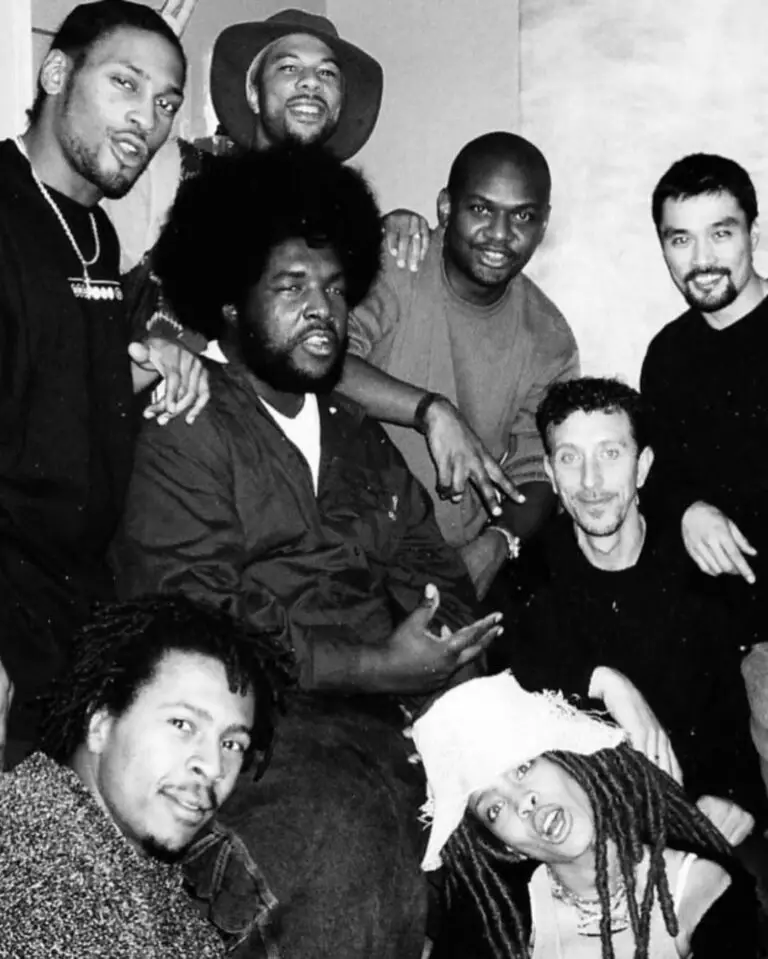
Questlove recognized that D’Angelo’s Brown Sugar was influenced by production techniques akin to those of J. Dilla, particularly with the group The Pharcyde during that era. In 1996, while performing at The House of Blues, The Roots noticed that D’Angelo, who was in the audience, seemed disinterested in their show. Midway through the set, Questlove focused on D’Angelo, sensing his lack of engagement, and decided to incorporate J. Dilla’s signature drumming style. This adjustment seemed to intrigue D’Angelo as he began to nod his head to the beat, and unbeknownst to Questlove, Erykah Badu was standing next to D’Angelo.
After the show, D’Angelo requested Questlove to join him for his upcoming album, and they arranged studio time at Electric Lady Studios in New York, which ultimately became their home for the next 5-6 years. Electric Lady Studios was established by Jimi Hendrix, who, due to his early death, had only a brief period to record there. Notable artists like Stevie Wonder and David Bowie had the opportunity to create music in the same studio that now gave rise to the Soulquarians. D’Angelo even had the opportunity to use the same keys as those featured in some of his all-time favorite tracks from Stevie Wonder’s Talking Book, which fueled the inspiration for the music to be made. Initially, their goal was to focus on D’Angelo’s forthcoming album, Voodoo, but Questlove was also working on The Roots’ next project, Things Fall Apart. At first, Questlove had to travel between two studios located across the country from one another, but eventually relocated The Roots’ session to Electric Lady Studios.
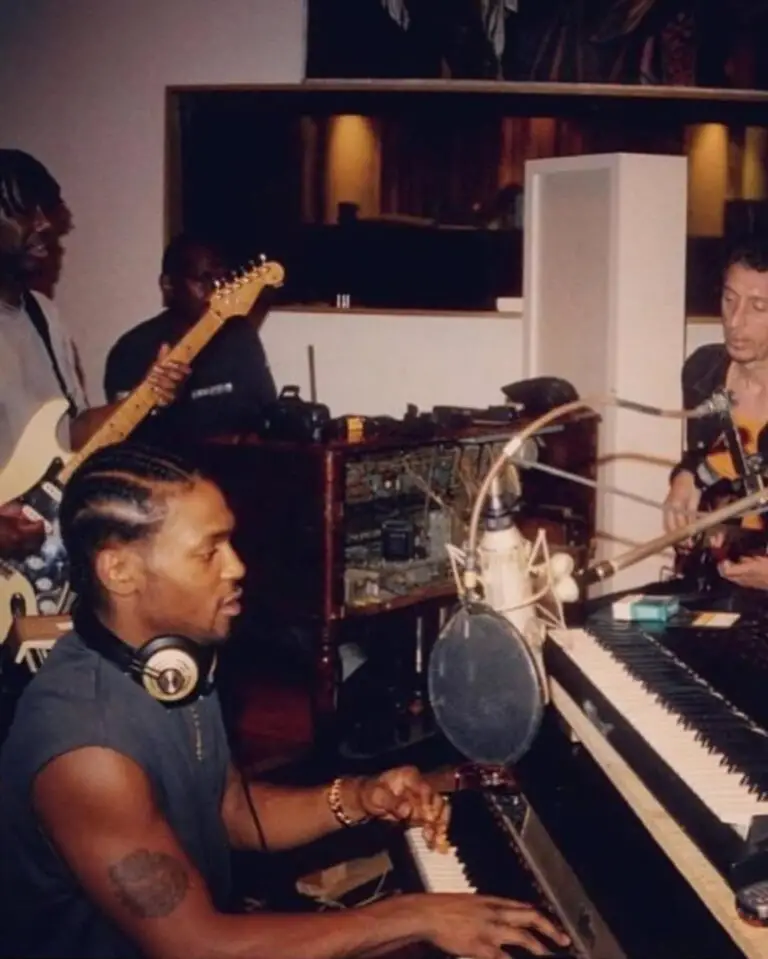
During this period, James Poyser and J. Dilla were invited to the studio to work on various production elements, cultivating a group of like-minded musicians, leading to the formation of the Soulquarians with these four individuals as foundational members. Over time, additional artists such as Erykah Badu, Common, and Q-Tip joined this collective, among others. Many of these musicians coincidentally recorded in the same studio simultaneously, resulting in some of their finest works, including Common’s Like Water For Chocolate, D’Angelo’s Voodoo, and Erykah Badu’s Mama’s Gun.
The era of the Soulquarians is vastly underappreciated. When looking at the collective’s body of work today, it’s easy to identify the connection between them and artists like Anderson .Paak and Thundercat, while they also serve as a significant influence on Kendrick Lamar’s To Pimp a Butterfly and may be the reason why modern jazz artists such as Kamasi Washington and soul queen Celeste seem relevant – it’s not an exaggeration to view the Soulquarians as the custodians of live instrumentation and the jazz and soul impact found in today’s hip-hop scene.
The Falling Out of The Soulquarians
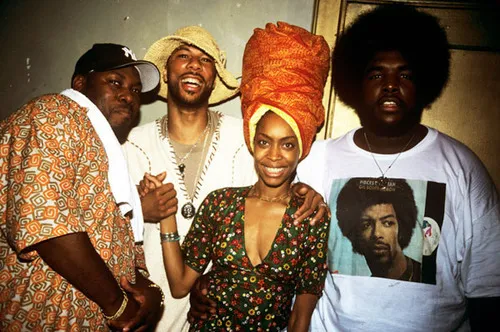
Questlove has mentioned that the dissolution of the Soulquarians was largely due to the egos involved and that a photo shoot in late 2000 hindered the launch of the Soultronics group. While this may seem trivial, it’s not surprising, given the nature of the music industry. With record labels opposing their artistic vision, personal conflicts arising, and possibly just a natural drifting apart after years of collaboration, the Soulquarians ultimately faded away from each other, preserving some connections while others deteriorated. Common and Erykah Badu, who were in a relationship during the peak of the Soulquarians, eventually separated. D’Angelo went off the radar for 14 years before making a comeback with Black Messiah. Q-Tip faced his own challenges, and the tragic loss of J. Dilla in 2006 further complicated matters, preventing things from returning to their former state. No matter if egos influenced their separation, the Soulquarians still draw attention whenever they make a move now. Their impact endures powerfully, even after many years.
The Soulquarians’ Contemporary Influence
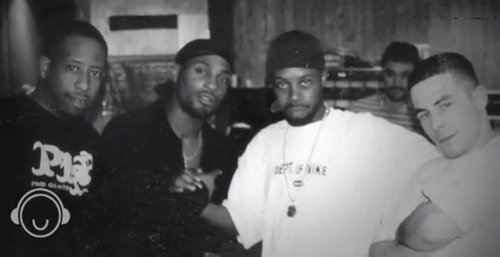
From hip-hop artists to soul musicians, traces of the Soulquarians can be felt in the most cutting-edge music of today. The jazz influence in Kendrick Lamar’s albums, especially in his third studio album To Pimp A Butterfly, is evident. You can hear it in the music of bassist Thundercat and his frequent partners, Terrace Martin and Robert Glasper. Take note of Beyoncé, Solange, SZA, H.E.R., and Janelle Monáe – all of them have been inspired by Erykah Badu’s Mama’s Gun, with its bold, world-weary, love-driven lyrics and the empowerment of the free Black woman.
The Soulquarians created a warm and fun sound, reflecting a 1970s nostalgia while remaining forward-thinking, and it was something that soul and hip-hop had not experienced in years. Those legendary sessions shifted the focus of popular music toward the significance of live instruments and teamwork. Ultimately, they crafted a musical movement built on African rhythms and exceptional creativity.
Notable Albums:
The Roots – Things Fall Apart
Released on February 23, 1999, The Roots’ groundbreaking, platinum-certified album Things Fall Apart marked the beginning of the Soulquarians era. Named after the classical novel by Chinua Achebe, which depicts the lives of people in southeast Nigeria before colonialism, Things Fall Apart includes contributions from Common, Mos Def, and Erykah Badu on vocals, along with D’Angelo and James Poyser on keyboard and J. Dilla on production. The last song to be included in the final selection was “Double Trouble,” featuring Mos Def. Initially, the song was supposed to feature a guest appearance from Mos Def’s Black Star partner, Talib Kweli, but due to the format of the track, it was decided to make it a throwback to the Run D.M.C. tag-team style of rap, with just two MCs.
Things Fall Apart illustrated how deeply soulful hip-hop can resonate when paired with live music, and it elevated The Roots from a niche following among jazz-rap enthusiasts to a globally recognized, best-selling ensemble.
Mos Def – Black On Both Sides
Released on October 12, 1999, after a successful collaboration with Mos Def & Talib Kweli Are Black Star, Black on Both Sides dropped as a more traditional hip-hop album compared to The Roots’ Things Fall Apart, yet it remains equally innovative, delving into Brooklyn rap with “Mathematics,” DC hardcore with “Rock N Roll,” and Aretha Fraklin’s Souther soul with “Ms. Fat Booty.” Ali Shaheed Muhammad, known mostly as a member of A Trible Called Quest, produced the seventh song, “Got.” Mos Def was previously part of the overlooked duo Black Star alongside fellow Soulquarian Talib Kweli, and his smooth East Coast delivery and catchy bass lines were ahead of their time – his lyrics address issues such as pollution, the economy, and self-care, among other topics that have become prevalent in 21st-century hip-hop. Mos Def explores highbrow, metaphysical concepts throughout the record: “People be askin’ me all the time, ‘Yo Mos, what’s gonna happen with hip hop?’ … I tell ‘em, ‘You know what’s gonna happen with hip hop? Whatever’s going on with us.” Alongside Nas’s Illmatic, Black on Both Sides is considered one of the pivotal hip-hop solo debuts.
Q-Tip – Amplified
Released on November 30, 1999, when Q-Tip was still just 29, he had already fronted and produced five albums for A Trible Called Quest, with three of those considered among the best in alternative hip-hop. He brought that innovative spirit to Electric Lady Studios and the Soulquarians. While Amplified isn’t among many people’s top picks among Soulquarians’ albums, it captures moments of beauty. “Let’s Ride” stands out as one of the best tracks Q-Tip has contributed to, and “Wait Up” showcases a distinctly different sound from his Tribe days, combining gritty percussion with bright piano, catchy brass, and driving bass synths, it could easily fit into N.E.R.D.’s debut album In Search Of…, which released three years later. Q-Tip was one of the most active members of the Soulquarians, appearing on various other albums as both a rapper and producer. He served as a mentor figure who would eventually be overshadowed by those he taught.
D’Angelo – Voodoo
Released January 25, 2000, Voodoo is considered one of the finest albums of the 2000s. D’Angelo’s second studio album stands in the middle of Soulquarians’ 20th anniversary and is on par with Erykah Badu’s Mama’s Gun as a fundamental release in the neo-soul genre. D’Angelo produced Voodoo using 2” tape, a recording technique that dates back to 1952, featuring instruments like the same Fender Rhodes electric piano that Stevie Wonder used on Music of My Mind and Talking Book – both of which were also crafted at Electric Lady Studios.
The result is an album that evocatively brings back the gritty essence of the Motown era. While deeply soulful, the group’s hip-hop influences remain evident throughout. “Devil’s Pie” showcases one of the very best basslines in hip-hop, yet, true to Soulquarian principles, it offers a critical perspective on the genre’s vice-laden culture. Together with Things Fall Apart and Mama’s Gun, Voodoo was one of the three Soulquarian albums to achieve platinum status, but it is unique in being the only one to receive a Grammy award.
Common – Like Water For Chocolate
Released on March 28, 2000, Like Water For Chocolate takes its name from a novel by Laura Esquivel and refers to a Spanish expression about reaching one’s boiling point. Nonetheless, like much of Common’s work, he repurposed the phrase to express Afrocentric ideas and the pursuit of universal love. Many of the artists from the Soulquarians produced their finest albums while they were part of the collective, indicating that the group often exceeded the contributions of its members. Common is one of those artists. While Mos Def reveals the diverse musical landscape that many rappers overlook, Common emphasizes the importance of peace and unity among hip-hop enthusiasts. This results in an album rich in social commentary, often leaving listeners unsure if they’re agreeing or simply enjoying the music.
Slum Village – Fantastic, Vol. 2
Released on June 13, 2000, Fantastic, Vol. 2 showcases the Soulquarians’ production at its finest, highlighting a masterful interplay between rhythm and beats – a positive aspect, considering the lyrics are slightly less polished in this album. Still, the album is a musical masterclass, with J. Dilla shining as the standout member at his peak. There’s no better place to experience him creating songs than just beat tracks – his use of the Akai MPC 3000 sampler has been likened to how Hendrix played guitar, while Questlove, who contributed most of the live drumming throughout these albums, acknowledged J. Dilla as a significant influence on his drumming style.
Erykah Badu – Mama’s Gun
Released on November 21, 2000, Mama’s Gun merges Badu’s soulful essence with the collective’s energy, pushing their musical expression into more experiential realms. Erykah Badu stands out as a distinctive artist within the Soulquarians, notably because her most acclaimed album was released before she joined the collective, and she is also the only female member. Although Badu was among the later additions to the Soulquarians, she embodies much of their essence – her sound is raw and gritty, showcasing her skill and drawing parallels with both Motown and jazz, particularly with Billie Holiday. The album is tender, sophisticated, beautiful, personal, and powerful throughout, addressing themes of Afrofuturism and insecurity. It is unified by a Soulquarian rhythm section featuring Questlove on drums, James Poyser on piano, and Pino Palladino on bass, who delve into their shared musical dialect with remarkable finesse.
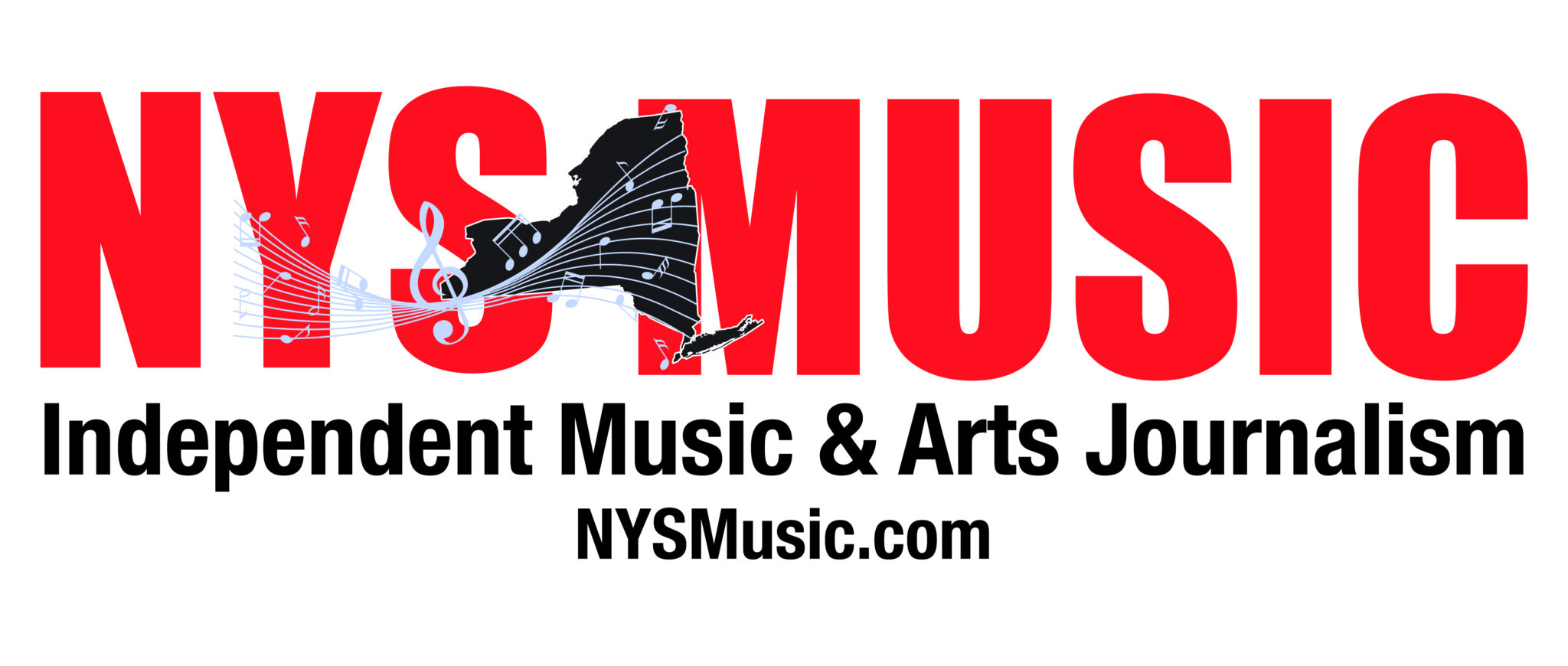

Comments are closed.